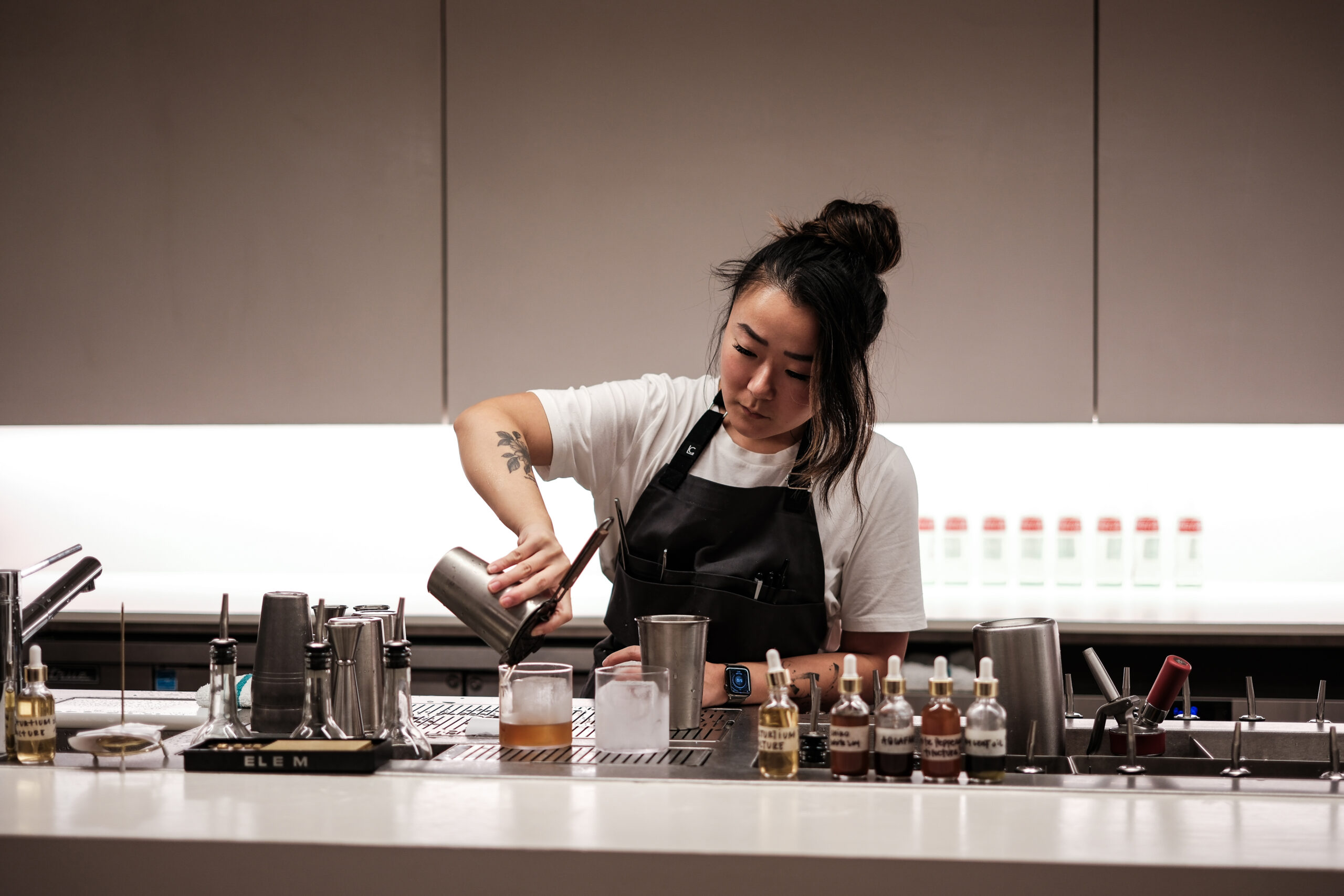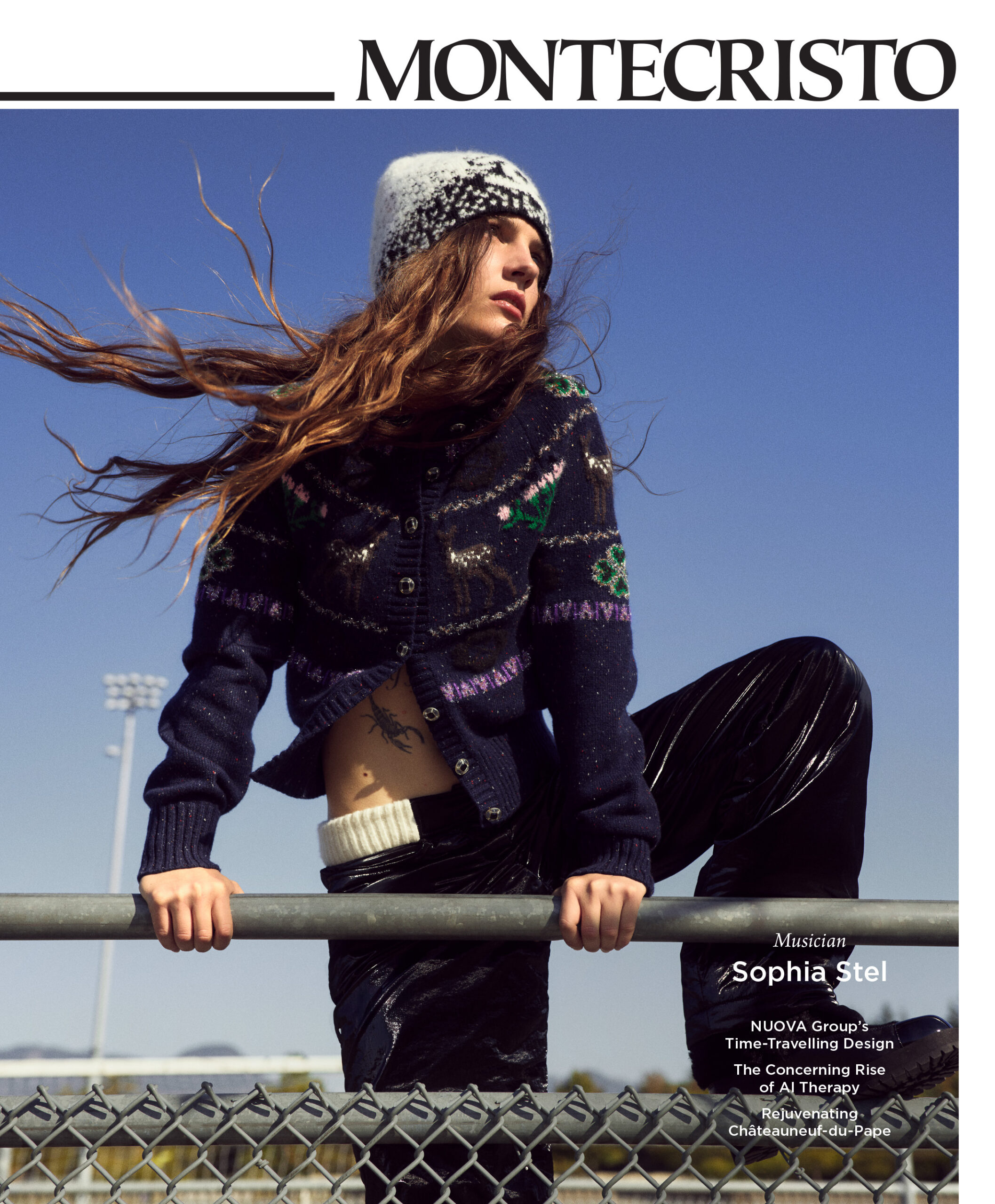Where others see waste, Winnie Sun sees potential.
When Sungold heirloom tomatoes from Stoney Paradise farm were brought into the kitchen at Elem, Sun seized upon the vines. Gently heating the usually discarded parts of the plant with vermouth, she created a bright tomato-infused aromatized aperitif that would form an essential part of one of the Main Street restaurant’s signature cocktails: the Chef’s Negroni.
Using unconventional ingredients and foods that would normally be considered waste in her cocktail program has become the calling card for rising star Sun, the ambitious, inventive, and self-taught 28-year-old beverage director and partner at Elem (with chef Vish Mayekar and restaurateur Hassib Sarwari), where the menu is inspired by the four elements: earth, water, fire, and air. Her zero-waste cocktail program draws both on Sun’s Chinese heritage and her love of travel.
Working hand in hand with Mayekar, a Top Chef Canada alumnus formerly of Pepino’s, Caffe La Tana, and Elio Volpe, Sun carries the ethos of sustainability directly from the kitchen to the bar. New life is given to food that would otherwise become waste: the house negroni also features gin infused with broken pieces of chocolate and Campari permeated with spent mulberries—notorious for their short shelf life. (“I actually have a shirt that says ‘I love negronis more than people,’” Mayekar tells me).
Each new dish presents an opportunity for Sun to rescue and recreate. Prawn shells left over from making prawn fried rice with house kimchi and Yarra Valley salmon roe are incorporated into gin for a matching cocktail. Excess liquid from pressing beets for goat cheese agnolotti are repurposed for an infused-whiskey creation. “I’m passing it on to Winnie and being like, hey, what can we do with this? And then, boom, beet manhattan,” Mayekar says, grinning.
But what just might be most impressive about the cocktail program is Sun’s commitment to creating zero-proof versions of their boozy counterparts. These intricately constructed drinks frequently confuse guests, who appeal to servers to make sure what they’ve been served is indeed alcohol-free. (To avoid confusion, the bar has been set up with two wells, one for alcohol and the other dry).
I’m intrigued: can they really deliver an identical flavour profile? I have to try them side by side. First up, Seoul, Elem’s take on a paloma. Served in a highball glass with a large stamped ice cube, the peach-coloured liquid is infused with caramel-infused Cazadores agave tequila (using waste from gochujang caramel petit fours), sesame oil, and grapefruit soda and topped with an airy savoury prawn cracker.
Sun preps me by saying the only true taste difference should be that the zero-proof spirit (here, HP agave) has a “crisper and cleaner” feel but still contains a good “kick” from the agave.
“Our menu reads in a way that if you don’t want to drink alcohol, it’s clear these are the cocktails we are able to make for you zero-proof.” —Winnie Sun
From the first sips, it’s honestly hard to distinguish which one is alcohol-free. Both have a smoky and floral aroma, and a spicier finish. The zero-proof does bring a hint of tequila warmth to it. They are, to my palate, locked in a dead heat for taste—and you’d have a hard time distinguishing between the two for mouthfeel.
Next, I stand at the bar to watch Sun create one of the most popular cocktails: a butternut squash old-fashioned, meant to be warm and rich, grounding and comforting. It’s infused with a house-made nasturtium tincture created with botanicals, as well as shiitake mushroom and maple syrup, with the zero-proof version using a non-alcoholic bourbon from Free Spirits. Again, the mouthfeel and overall flavour profile are remarkably similar in both glasses—despite missing the alcohol’s weight and heat, the hints of smokiness and warmth are present in both drinks. “You’re just missing the pungency of alcohol,” Sun says.
The creation of her cocktails, Sun explains, originates with the main culinary ingredient rather than the alcohol. For Seoul, she wanted to make something Korean inspired using gochujang, then brought in the alcohol—tequila—to match its flavour profile. For another, the Mexican Coca Cola, she began with an authentic mole sauce and then paired it with mezcal.
There is, she says, much more nuance in constructing zero-proof versions. Different ratios and balancing are required—the non-alcoholic spirits already contain sugar or malic acid, which reads more acidic. Sun says it’s unlikely a zero-proof cocktail will ever be a 100 per cent taste match because the alcohol by volume isn’t there. But a recent proliferation of alcohol-free spirits made by treating botanicals the same way as their traditional counterparts is making it possible to come much closer.
Certain flavour profiles of alcohol—say, a smoky bourbon—can be amped up through techniques of smoking and external infusions, ironically making the traditionally booze-forward bolder end of the cocktail spectrum—old-fashioneds, negronis—easier to recreate as zero-proof. Much harder, Sun says, are the more “fun” drinks such as a piña colada, in which you can still taste the rum under the sweet, tropical mix. “Once you make that zero-proof, it is harder to taste that distinctive alcohol that you’re looking for,” she notes. “It becomes trickier to balance.”
And, she adds, in some instances, successfully recreating a classic cocktail without the alcohol is impossible. This is why you will not find a sour on the zero-proof list at Elem—the chemistry won’t allow it. The egg white or aquafaba (chickpea water) used to create the foam in a sour won’t coagulate without the alcohol, so you can’t achieve the same effect. Added to that, most zero-proof liquors have a higher citric acid content and more pronounced acidity profile to contend with, so adding the lemon juice required, Sun says, can result in “an unbalanced, sour taste that’s unpleasant to drink.” Adding extra sweetness to compensate can quickly become “cloying or overpowering,” she notes.
A self-taught mixologist and law school graduate—who switched to hospitality full time during COVID—Sun cut her teeth at Sarwari’s first Vancouver restaurant venture, Zarak. With its opening on Main Street in 2021, she took zero-proof drink creation to the next level, incorporating Afghan ingredients such as cardamom, cumin, mango, and pomegranate. With its significant Muslim clientele—and most of Zarak’s staff—being non-drinkers, Sun tested her ideas on the team. “They would talk about their lives in Afghanistan and that would inspire her to create something that would remind them of their roots and culture,” Sarwari says, noting that half of the kitchen team are Afghani refugees.
Creating a seamless cocktail menu, inclusive to everyone, became extremely important to Sun when opening Elem. “Our menu reads in a way that if you don’t want to drink alcohol, [it’s clear] these are the cocktails we are able to make for you zero-proof,” she says. “I think that’s a way better alternative than having three to four less interesting mocktails on the menu.”
The reception of the zero-proof cocktails since opening in the fall has, she says, been a runaway success, with sales as strong as for their full-strength counterparts. And with half the cocktail menu already revamped or changed from the initial offerings, next up for Sun and the evolution of the program is more experimentation with bold and unexpected ingredients. Behind the bar are a variety of glass containers holding liquids of all colours and ingredients and potions she’s yet to incorporate—but can’t wait to experiment with.
“Lotus seed, all sorts of Mexican peppers, a few sitting lacto-fermentations such as corn kernels, sweet pepper, some sentimental Chinese ingredients such as green and red bean,” she lists. “The wheels are always turning.”
Read more from our Spring 2025 issue.









